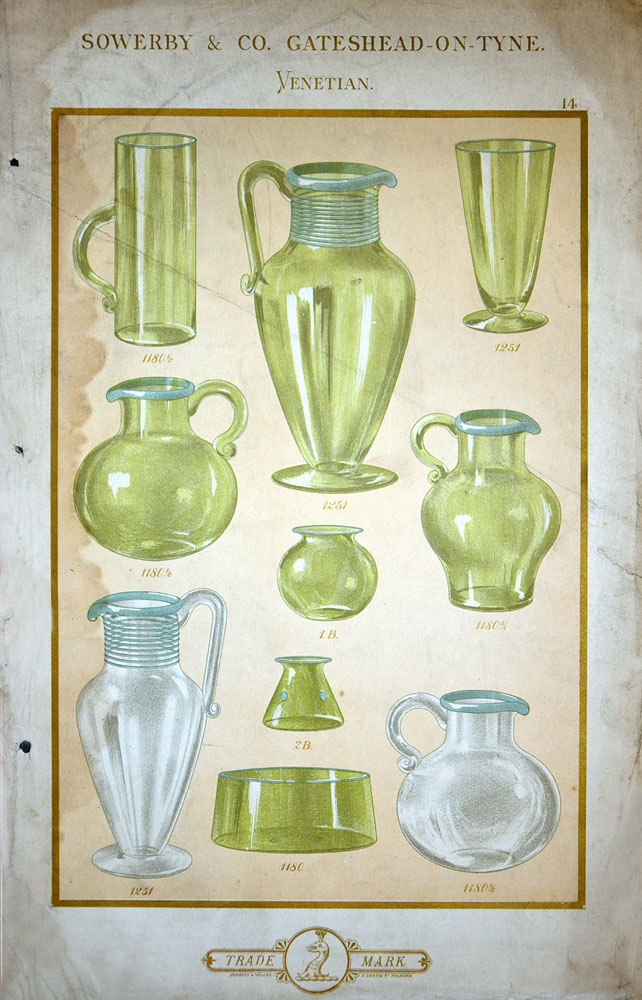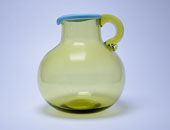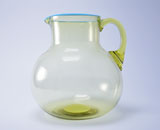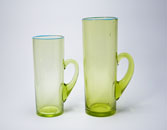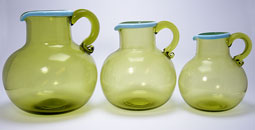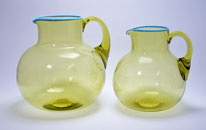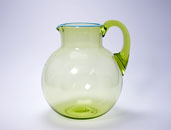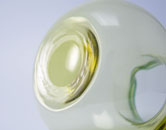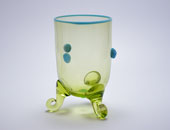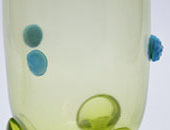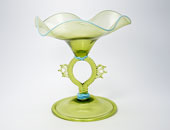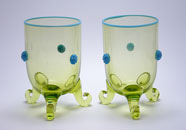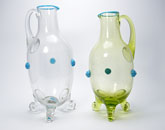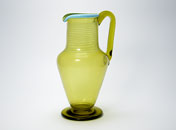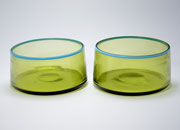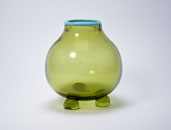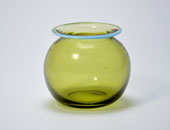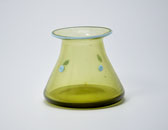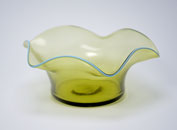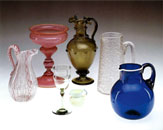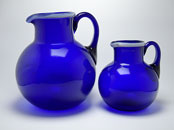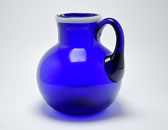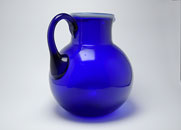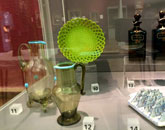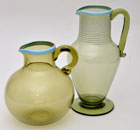Sowerby Venetian Glass
References to Sowerby Venetian glass in the standard pressed glass texts;
Cottle (page 76-77) Art and Venerian Glass chapter, describes Venetian Glass with two colour plates.
Murray (page 37) where the author describes the Venetian series, where a smoky brown version of the glass is also mentioned.
There is also a colour plate 34 which shows two examples of Venetian glass.
Hajdamach (Page 267) which refers to three pieces of Sowerby glass shown in Plate 23 on page 256.
The book 'Victorian Table Glass and Ornaments' by Barbara Morris also mentions Sowerby Venetian (Page 145) "Somewhat similar to some of Powell's Venetian-style glass was the Venetian Glass of Sowerby & Company's Ellison Glass Works, Newcastle upon Tyne, although it was cruder and less thinly blown. This glass appears to have been made in the late 1860s and 1870s and consisted of jugs, footed tumblers and vases, made in olive green glass, with pale blue rims, sometimes decorated with blue threads and applied prunts. Some of the jugs had round bellies with short necks, others were taller with ovoid bodies and the shapes were deliberately slightly irregular. It was also made in clear glass, again with pale blue rims. Although the inspiration was said to be Venetian, it possibly has more affinity with Nailsea and Bristol glass of the early nineteenth century."
This page will introduce further information about Sowerby Venetian glass from my own collection and observations.
Page 14 from Sowerby's 1880 Pattern Book VIII.
This page is from the only known contemporary publication which shows any of Sowerby's 'art' glass production, the rest of the pattern book contains small, pressed, fancy items in vitro-porcelain.
Sowerby's have named this glass 'Venetian' and as the pattern books were produced for the glass trade we can assume Venetian was a trade line at this time.
Venetian is mentioned on the front of the 1882 pattern book as being available in 'several colours'.
The glass was usually made in either pale green or flint glass with opaque turquoise edge decoration, threading or prunts. The turquoise glass used is Sowerby's turquoise vitro-porcelain.
There are several other examples of this type of glass, the designs for which do not appear on this page in the 1880 pattern book.
It will be noted that the handles in the jugs and beakers have a distinctive 'curl' where the handle is attached at the bottom of the item, and the turquoise lip on the jugs is quite wide.
There are also variations to the patterns of this type of glass.
Handle Variations
The first two pictures above show two versions of a typical Venetian bulbous jug.
The first picture shows a jug that has the characteristics shown in the pattern book, a handle with a 'curl' at the bottom and a wide turquoise band on the top lip. This deeper band is added to the side of the rim of the jug.
The second picture shows a jug that has a handle wider at the bottom with no curl, a thin turquoise rim and a green colour which is paler than the first jug. The thin turquoise band is applied to the top of the rim of the jug.
The third and forth pictures show lemonade glasses with the different types of handles.
Colour Variations
When a number of Venetian pieces are compared it can be seen that different shades of green glass have been used. This is not always obvious as in the three pictures above, please click on the images to see the differences.
The first picture shows a green glass with a darker tone. This green has very little or no reaction to UV light. Some of the pieces in this colour also exhibit a kind of 'damp' surface, if a finger is rubbed on the surface it will 'squeak'.
The larger jug on the left is darker in colour due to the glass being much thicker (and heavier) on this jug.
Objects made from this dark green glass tend to be the ones which are illustrated in the 1880 pattern book as in the picture at the top of the page.
The second picture shows a green glass with a straw yellow-green tint. This green does react to UV light, on a jug the base of the handle will react more than the body. The darker the yellow tint the stronger the UV reaction.
The third picture shows a green glass which has a pale green, vaseline, tone. This green exhibits a very strong UV reaction, illuminating the whole object.
This is not a definitive list, for example some dark green pieces do react to UV light, but from this it can be seen that various 'mixes' of green glass were used for Venetian glass.
Other Attributes
The first picture shows the pontil mark on a Sowerby Venetian jug. All the pieces of Sowerby Venetian I have seen, have ground out and polished pontil marks.
The second picture shows a 3-footed spooner which has lost one of it's raspberry prunts. Normally a pre-stamped prunt would be applied directly to the hot body of the glass, these prunts have been applied differently.
The third picture shows how a small, round, flat disc of turquoise glass has been applied to the body of the glass then a turquoise prunt has been applied to the disk. The prunts can fall off leaving the flat disk. This is an unusual way of applying prunts and one that may be used to recognise this type of glass.
Some pieces of Venetian can be very thin and delicate, see the wavy edge dish and Tazza in the Gallery below, others, especially the jugs with the darker green glass and wide turquoise rims have thicker glass and can be quite heavy.
Venetian Glass Gallery
Possibly Sowerby
Two blue glass jugs 14 and 19.5cm tall respectively, very similar to jugs in the Venetian range. There is a picture of one of these jugs in Hajdamach, Plate 23 page 257 which is is labeled 'possibly Sowerby'. Both jugs have a thick top rim band, this time in white (opal) glass. The opal rim on the larger jug is a streaky white glass, not fully opaque. The pontil on smaller jug is ground smooth, on the larger jug the pontil has not been ground after breaking off.
Venetian glass was very popular at this time and a number of glass manufacturers were making 'Venetian' style glass. Similar jugs were made by other companies but characteristics and colour suggest these blue jugs may well have been made by Sowerby's.
Observations
The first picture above shows two pieces of Venetian displayed at the Eat, Drink and Be Merry exhibition at the Shipley Art Gallery In Gateshead in 2015. The jug with turquoise rim, prunts and three snail feet has a handle without a 'curl'. This jug was originally in the Michael Parkington collection. It is possible the Venetian glass with handles without curls was made by a manufacturer other than Sowerby. We do not know the exact provinence of this jug but the Shipley Art Gallery evidently thought it correct enough to buy and display it as Sowerby Venetian.
While other companies made similar glass, I believe that the different versions of this Venetian glass were made by the workers in the Sowerby Art Studio over a number of years, experimenting with different green glass mixes and patterns. Like other pressed glass factories Sowerby used uranium to produce yellow/green candlesticks and other items from the early 1870's. The turquoise vitro-porcelain used for the rims and prunts on the glass does vary in colour slightly, especially on the jugs without the curled handles. This type of glass was patented in 1876 so would have been used from this date or possibly slightly before. It may be that sometime around 1878-1879 a decision was made to 'standardise' the glass colour and shapes and include these in the 1880 pattern book so the glass could be sold to trade outlets.The front of the 1882 pattern book mentions Venetian glass so it was still available at this time. The method for attaching the curled handle was mainly used before 1860 while the other method, thick, round end at the bottom, was mainly used after 1860 (The Arthur Negus Guide to British Glass, John Brooks, Pg 152). The curled handle would have been more time consuming to make, but this may have been adopted by Sowerby, with the finishing curl, to produce a visually unique product.
The second picture is from an auction a number of years ago. Two Venetian jugs, both have curled handles. The taller threaded jug is in dark green glass, the other jug appears to be made with yellow-green glass. This appears to prove that Sowerby made items in this yellow-green glass.
In conclusion, until other evidence comes to light, I believe this glass was all made at the Sowerby factory, possibly over a number of years and not in great numbers. I would be interested to hear from anyone who has any of this type of glass or more information about it.

